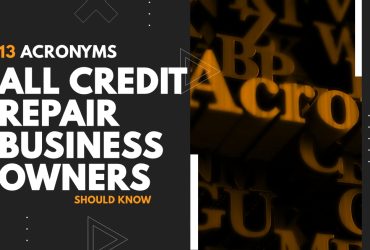Social Media Strategies for Growing Your Online Credit Repair Business
by Almas Tariq
May 16, 2025
03:35 PM

In the digital age, social media isn’t optional—it’s essential for growing your online credit repair business. Platforms like Instagram, Facebook, TikTok, LinkedIn, and YouTube allow you to connect directly with consumers who need your help. But in a highly regulated industry like credit repair, your social media strategy must be both strategic and compliant.
In this blog, we’ll explore how credit repair business owners can use social media to grow their brand, generate leads, and educate consumers—while staying within the legal guidelines of the Credit Repair Organizations Act (CROA), Fair Credit Reporting Act (FCRA), and other consumer protection laws.
🔍 Why Social Media Matters for Credit Repair Businesses
- Over 70% of adults use social media daily to consume news, ask questions, and look for recommendations.
- Most credit repair prospects are already online—searching for answers to credit-related questions.
- You can use social media to establish trust, demonstrate your knowledge, and attract organic (and paid) leads without cold-calling or spamming.
But here’s the key: compliance first, content second. Everything you share must be accurate, transparent, and legally safe.
⚖️ First: Stay Compliant with CROA on Social Media
Before jumping into tactics, here’s what you cannot do on social media as a credit repair business, based on CROA and FTC guidance:
❌ Don’t:
- Guarantee specific results like “Remove all negative items in 30 days” or “Raise your score 100+ points overnight.”
- Post before-and-after credit scores without proper context or disclaimers.
- Use testimonials that suggest guaranteed results unless they represent typical outcomes and include proper disclosures.
- Promote illegal practices like “credit sweeps” or using CPNs (Credit Privacy Numbers).
- Charge for services before they are rendered (especially if promoted via social platforms).
✅ Do:
- Use social media to educate your audience on credit rights and best practices.
- Share success stories with disclaimers (e.g., “Results vary. No specific outcome is guaranteed.”)
- Promote free consultations and secure lead capture forms.
- Provide general financial literacy content to build credibility.
📲 1. Choose the Right Platforms for Your Audience
Each social media platform has a different audience and content style. Here’s where credit repair businesses see the most success:
Instagram & Facebook
- Great for storytelling, video tips, testimonials, and community building.
- Use Instagram Reels and Facebook Live to answer FAQs in real-time.
- Run compliant Facebook Ads to drive leads to a secure opt-in form or landing page.
TikTok
- Perfect for educational short-form content (30–60 second clips).
- Use trending audio + simplified visuals to explain credit myths and laws.
- Stay compliant: Use disclaimers and avoid overpromising.
- Target real estate agents, mortgage brokers, and financial pros for B2B referral partnerships.
- Share credit tips, law updates, and case studies.
- Position yourself as a compliance-focused professional, not a salesperson.
YouTube
- Best for long-form credit education: “How to Read a Credit Report” or “What Is FCRA?”
- Great for SEO and attracting leads from YouTube Search & Google.
- Build authority with playlists: Credit Basics, Common Mistakes, and Legal Rights.
🧠 2. Use an Educational Content Strategy
Your goal is to become a trusted voice in credit education. Instead of pitching services, provide consistent, valuable insights. This builds trust and converts viewers into clients over time.
Content Types That Work:
- Myth-busting videos: “Can paying off a collection hurt your score?”
- Quick tips: “3 ways to lower credit utilization fast”
- FAQ posts: Answer common questions like “How long do late payments stay on your report?”
- Law insights: Simplify consumer rights under CROA, FCRA, and FDCPA
- Storytelling: Share a client win (compliantly!) with a message of hope and empowerment
- Weekly themes: Try “Credit Tip Tuesday” or “Fix-It Friday”
✅ Pro Tip: Always use disclaimers like:
“This content is for informational purposes only and does not guarantee specific results. Consult a professional for personalized advice.”
💬 3. Build Engagement with Authentic Communication
Social media is not just a broadcast tool—it’s a two-way street. The algorithm favors engagement, so the more you interact with your audience, the more visible your content becomes.
Ways to Increase Engagement:
- Ask questions in your captions: “Have you checked your credit this year?”
- Use Instagram Stories to run polls, quizzes, or Q&As
- Respond to all comments and DMs (while avoiding personal financial advice in public threads)
- Celebrate follower milestones or shout out happy clients (with written permission)
💡 Engagement = Trust. Clients are more likely to hire someone who feels approachable, consistent, and ethical.
💼 4. Leverage Paid Ads (Compliantly)
Facebook and Instagram Ads are excellent for reaching new audiences—but they must be carefully written to avoid compliance violations or account bans.
Paid Ad Compliance Tips:
- Never say “We’ll fix your credit” or “Guaranteed deletions.”
- Use phrases like:
✅ “Struggling to understand your credit report?”
✅ “Book a free consultation to review your credit with a professional.” - Link to a secure landing page with proper disclosures, privacy policy, and terms of service.
📢 Remember: Paid ads are subject to Meta’s Special Ads Categories (credit-related services), which limit targeting options. Adjust expectations accordingly.
🔐 5. Use Secure & Professional Tools for Lead Capture
Don’t ask for sensitive personal information (like Social Security Numbers) through DMs or comments. Always use a secure lead form or CRM-integrated system that protects user data.
Recommended:
- Use platforms like ScoreCEO to handle lead forms, onboarding, and client communication securely.
- Use landing pages with SSL encryption, and clear compliance language.
- Include opt-in checkboxes and privacy policies on all lead forms.
📅 6. Stay Consistent with a Posting Schedule
You don’t need to post every day—but you do need to be consistent.
Start with this schedule:
- 3–4 posts/week: Mix of tips, videos, client wins, and FAQs
- 1 live Q&A/month: Build personal connection
- 1 story/day: Behind-the-scenes or quick updates
- 1 email/week: Repurpose your top content into an email blast
Tools like Later, Metricool, or Canva Content Planner help batch and schedule posts ahead of time.
🧩 Final Thoughts: Grow Your Business With Clarity, Integrity, and Strategy
Social media is a powerful tool—but in the credit repair world, compliance must lead the conversation. Don’t fall for hype, risky trends, or one-size-fits-all tactics. The most successful credit repair entrepreneurs on social media grow by being:
- Consistent in posting and branding
- Compliant with CROA, FCRA, FDCPA, and advertising rules
- Educational in tone and message
- Authentic in how they engage their community
Stay in your lane, serve with transparency, and use social media to empower and educate—not manipulate or mislead.
🎯 Need Help With Compliant Marketing?
ScoreWayU offers free resources, training, and templates designed to help credit repair professionals grow legally, ethically, and effectively online.
Visit our platform today and access:
- Social media content templates
- Compliant ad copy
- Weekly planning calendars
- Lead generation strategies
- And more—all free
❓ Frequently Asked Questions (FAQs)
-
Can credit repair businesses advertise on Facebook and Instagram?
Yes, but you must comply with Meta’s Special Ad Category rules for credit services. Avoid misleading claims and use secure lead capture pages with proper disclosures.
-
What kind of content can I post on social media as a credit repair company?
Focus on education, credit tips, myth-busting, and consumer rights. Avoid promising results or guaranteed score increases. Always include disclaimers for transparency.
-
Is it legal to share client testimonials or before-and-after credit results?
Yes, but only with written permission and clear disclosures. The FTC requires that testimonials reflect typical results and not mislead viewers. Always follow CROA guidelines.
Table of Contents
Explore More Insights
Dive deeper into a wealth of knowledge. Discover a multitude of articles covering diverse topics, expert perspectives, and the latest trends. Feed your curiosity and expand your understanding.



